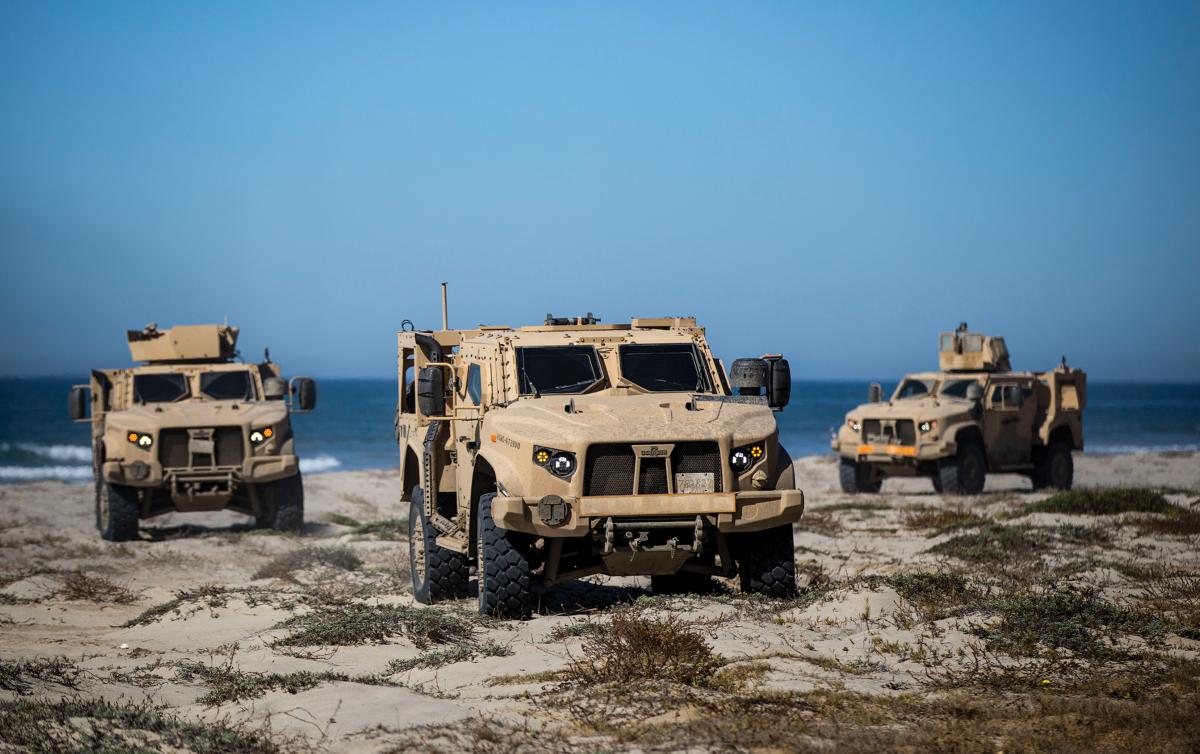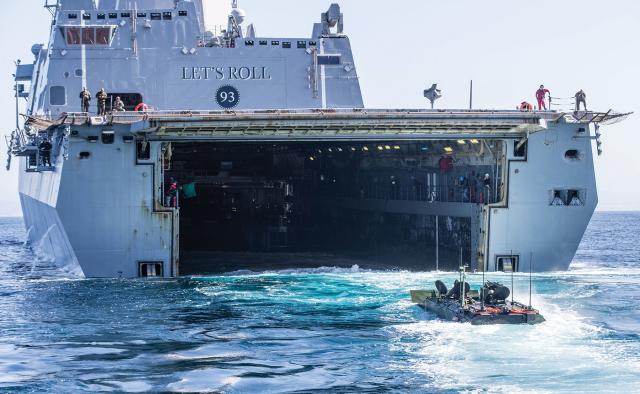The Marine Corps has been experimenting with expeditionary air-defense systems for the past several years. The Marine Air Defense Integrated System (MADIS) program offers a solution for conventional air and unmanned aerial system (UAS) threats. MADIS can be deployed on Joint Light Tactical Vehicles (JLTVs) and the light LMADIS offshoot on Polaris MRZR all-terrain utility tactical vehicles (UTVs). The latter vehicle, below, is small and light enough to be carried inside CH-53 helicopters and MV-22 Ospreys.
The LMADIS system operates from pairs of Polaris UTVs, one carrying sensors and the other defensive systems. According to C4ISRNet and GlobalSecurity.org, the detection system consists of a four-face RPS-42 tactical air-surveillance radar, a Skyview radio-frequency (RF) detection system, a Sierra Nevada Modi RF jammer, and a gyro-stabilized CM 202 electro-optical/infrared camera, all controlled from a tablet in one of the UTVs.
If LMADIS identifies a hostile UAS, Marines in the second UTV use the system’s electronic warfare suite to jam the link between UAS and pilot to knock the drone out. Sam LaGrone of USNI News reported that an Iranian drone that was harassing the USS Boxer (LHD-4) in July 2019 was taken down by an LMADIS system on the Boxer’s flight deck.
According to the Marine Corps, the heavier MADIS system on JLTVs, above, does more than jam drones. It uses a similar suite of sensors to identify threats, then employs a 7.62-mm minigun or even Stinger antiair missiles to destroy targets.
The LMADIS system has returned to the United States after its test deployment in 2019. The Marine Corps is considering whether to establish formal programs of record for both systems, with a decision expected soon.
Russia’s Hypersonic Antiship Missile Gets Shipboard Test
Russia Ministry of Defense
The TASS News Agency reported at the end of February that the Russian Navy has test launched its hypersonic 3M22 Tsirkon (“Zircon”) antiship cruise missile from a ship.
The frigate Admiral Goshkov, lead ship of a new class commissioned in 2018, launched a missile from the Barents Sea in the Arctic Ocean. TASS reports that the missile traveled “more than 500 kilometers” to a ground target in the Ural Mountains, inside Russia. TASS says this was the first ship-based launch of the missile.
Joseph Trevithick of The Drive reported in January that the missile’s development program is suffering from “childhood diseases.” Trevithick quotes Admiral Nikolai Yevmenov, Commander-in-Chief of the Russian Navy, from an interview he gave to state-run media agency RIA Novosti in late 2019. Yevmenov did not elaborate on what “diseases” were affecting the program’s development, saying only that the missiles would become a part of the fleet “in the coming years.”
An amphibious combat vehicle (ACV) with the Amphibious Vehicle Test Branch, Marine Corps Tactical Systems Support Activity, prepares to enter the amphibious transport dock USS Somerset (LPD-25) as part of the vehicle’s developmental testing off Camp Pendleton, California, in January. The new amphibious vehicle will replace the current amphibious assault vehicle. The testing consisted of Marines entering and departing a Navy well deck in an ACV for the first time to assess how well the vehicle can integrate on board ships. The ACV is expected to achieve initial operational capability later this year.
Joe Gould, “Marine Corps Counter-Drone Experiment Ends This Year,” C4ISRNet.com, 7 May 2019
“Light Marine Air Defense Integrated System [LMADIS],” GlobalSecurity.org
Sam LaGrone, “Marines Took Out Iranian Drone for the Cost of a Tank of Gas,” USNI News, 19 July 2019
Megan Eckstein, “Top Stories 2019: Marine Corps Acquisition,” USNI News, 30 December 2019.
Joe Trevithick, “Russian Navy’s Top Officer Says Shadowy Zircon Hypersonic Missile Has ‘Childhood Diseases,’” The Drive, 21 January 2020
“Russia’s Northern Fleet continues tests of hypersonic weapons,” TASS, 28 February 2020.





